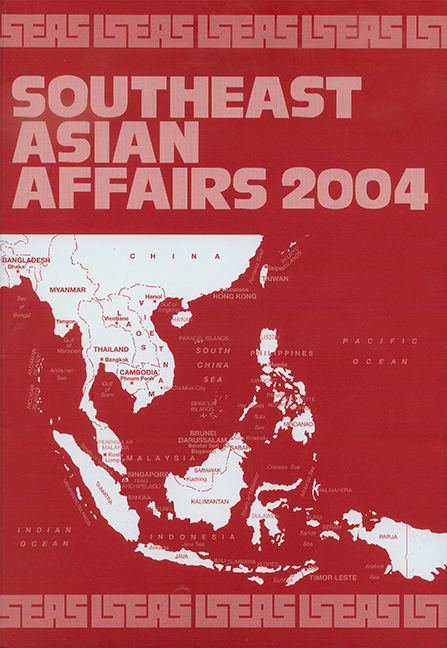Book contents
- Frontmatter
- FOREWORD
- Contents
- INTRODUCTION
- THE REGION
- ASEAN in 2003: Adversity and Response
- Southeast Asia's Economic Performance: Achievements and Challenges
- Southeast Asia–China Relations: Dialectics of “Hedging” and “Counter-Hedging”
- Terrorism in Southeast Asia: The Ideological and Political Dimensions
- BRUNEI DARUSSALAM
- CAMBODIA
- INDONESIA
- LAOS
- MALAYSIA
- MYANMAR
- THE PHILIPPINES
- SINGAPORE
- THAILAND
- TIMOR LESTE
- VIETNAM
Southeast Asia's Economic Performance: Achievements and Challenges
from THE REGION
Published online by Cambridge University Press: 21 October 2015
- Frontmatter
- FOREWORD
- Contents
- INTRODUCTION
- THE REGION
- ASEAN in 2003: Adversity and Response
- Southeast Asia's Economic Performance: Achievements and Challenges
- Southeast Asia–China Relations: Dialectics of “Hedging” and “Counter-Hedging”
- Terrorism in Southeast Asia: The Ideological and Political Dimensions
- BRUNEI DARUSSALAM
- CAMBODIA
- INDONESIA
- LAOS
- MALAYSIA
- MYANMAR
- THE PHILIPPINES
- SINGAPORE
- THAILAND
- TIMOR LESTE
- VIETNAM
Summary
Despite gloomy prognoses at the end of 2002, the war in Iraq and the emergence from China of a life-threatening Severe Acute Respiratory Syndrome (SARS), 2003 has turned out to be a year of reasonable economic progress in most parts of the ASEAN region. Preliminary estimates of growth in gross domestic product (GDP) by the Asian Development Bank (ADB) indicate that most countries have achieved faster growth in 2003 than in 2002 (Table 1).
The main exceptions are Laos and Cambodia, where the SARS outbreak had an adverse impact for tourism and Singapore where both SARS and the weak global demand for electronics caused a sharp decline in output in the second quarter, although there was some recovery in the second part of the year. Growth in Malaysia and Thailand in 2003 was well above that achieved in 2002, although Indonesia saw little improvement over the previous year, and in the Philippines economic growth is predicted to be slower than in 2002. Over the five years from 1998 to 2002 the fastest-growing economies in the region were Vietnam, Laos, and Cambodia. Vietnam in particular is expected to continue to grow rapidly in 2004. These three economies are the only ones in the ASEAN region whose growth rates over the past five years have come close to those achieved by China (Table 1).1 The stellar achievements of the Chinese economy since the mid-1990s, and the challenges which they pose for the ASEAN economies, continue to attract much attention in the region, and in most debates about future developments in the wider Asia-Pacific area. The success of China in attracting foreign direct investment and in expanding exports has inevitably raised fears about the longer-term competitiveness of the ASEAN economies. These fears are reinforced by the evidence from several countries that the growth recovery, to the extent that it is occurring, appears to be consumption-led rather than investment-led, and that export performance continues to be sluggish in spite of the considerable declines that have occurred in real exchange rates since 1995 (Table 2).
- Type
- Chapter
- Information
- Southeast Asian Affairs 2004 , pp. 18 - 34Publisher: ISEAS–Yusof Ishak InstitutePrint publication year: 2004



